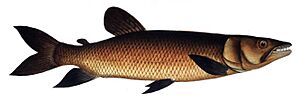African pike characin facts for kids
Quick facts for kids African pike characin |
|
|---|---|
 |
|
| Conservation status | |
| Scientific classification |
The Hepsetus odoe, also known as the African pike characin, is a type of fish that lives in freshwater. It's a predator, meaning it hunts and eats other fish. This fish belongs to a family called Hepsetidae. For a long time, people thought there was only one kind of Hepsetus pike characin. But new studies show that there are actually several different species. The Hepsetus odoe we are talking about here is the one found in West Africa.
Contents
What is the African Pike Characin?
Its Scientific Name and Family
The Hepsetus odoe was first officially described in 1794 by a German scientist named Marcus Elieser Bloch. He called it Salmo odoe. It was found near the "coast of Guinea," which is probably modern-day Togo or southeastern Ghana.
This fish is the main example for its group, the genus Hepsetus. People used to think it was the only species in this group and that it lived all over sub-Saharan Africa. However, research between 2011 and 2013 showed that there are actually several different species. The true H. odoe lives only in West and Central Africa. Its range goes from the Sassandra River in Ivory Coast to the Kienké River in Cameroon. Other similar fish found elsewhere are now known as separate species, like H. cuvieri and H. kingsleyae.
The genus Hepsetus is the only group in the family Hepsetidae. This family is part of a larger group of fish called characins.
Meaning Behind the Name
The name Hepsetus was suggested by William Swainson in 1838. He didn't explain why he chose it. But it likely comes from an ancient Greek word, hepsētós. This word meant a small fish, like an anchovy, that was cooked. It's interesting because Hepsetus odoe is a predator, not a small fish.
The name might be a nod to an old Greek poem. In the poem, an "hepsetus" fish eats an anchovy. It could also refer to how this fish looks similar to the South American characin Oligosarcus hepsetus, even though they are not closely related. This is called convergent evolution. The second part of its name, odoe, is the local name for this fish in Guinea. It probably refers to its many teeth.
What Does the African Pike Characin Look Like?
The Hepsetus odoe has a long, thin body. It looks a lot like a pike, which is why it's called a "pike characin." But it's important to remember that it's a characin, not a pike. They just look similar because they evolved in similar ways.
This fish can grow to about 28 cm (11 inches) long. Its back is usually dark brown or green. Its belly is silver. The head is often light green or brown. It has clear dark brown or black stripes that spread out from its eye. Adult fish usually have the same colors and patterns. But young fish can have more varied colors.
Where Does the African Pike Characin Live?
The Hepsetus odoe lives in western sub-Saharan Africa. You can find it from the Sassandra River in Cote d'Ivoire in the west. Its range extends east to the Shari River in the Central African Republic. It also lives southwards, reaching the Kienke River in Cameroon.
How Does the African Pike Characin Live?
Habitat and Lifespan
Hepsetus odoe likes calm, deep water. It usually lives for about five years.
Reproduction and Young
Spawning, which is when fish lay eggs, usually starts in August. It continues until January. In some places, the spawning season can last even longer, until May.
The female fish lays her eggs in a special bubble nest. The parents then guard this nest. They stay with the eggs until the young fish hatch and attach themselves to the bottom of the nest. After this, the adult fish leave the nest and their young. The bubble nest usually breaks apart about four days later. The young fish then spread out and live in areas with lots of plants along the water's edge.
Diet and Hunting Style
The Hepsetus odoe is a piscivorous fish. This means it eats other fish. It mainly hunts during the day. It's an ambush predator. This means it waits hidden among thick plants that are in or near the water. When another fish swims close enough, the pike characin quickly lunges out to catch it.
Its diet mostly includes cichlids and mormyrids. However, smaller Hepsetus odoe fish have been seen eating more mochokid catfishes than cichlids or mormyrids. This fish prefers the upper parts of small rivers. It especially likes areas where the long tigerfish (Hydrocynus forskahlii) is not common or is less abundant. The Hepsetus odoe uses weeds and plants, along with its natural coloring, to stay hidden from its prey and other predators.
How Do Humans Use the African Pike Characin?
People fish for Hepsetus odoe for a few reasons. It's caught for sport fishing. It's also eaten by people. Sometimes, it's caught and sold for the aquarium trade, meaning people keep them as pets in fish tanks.


